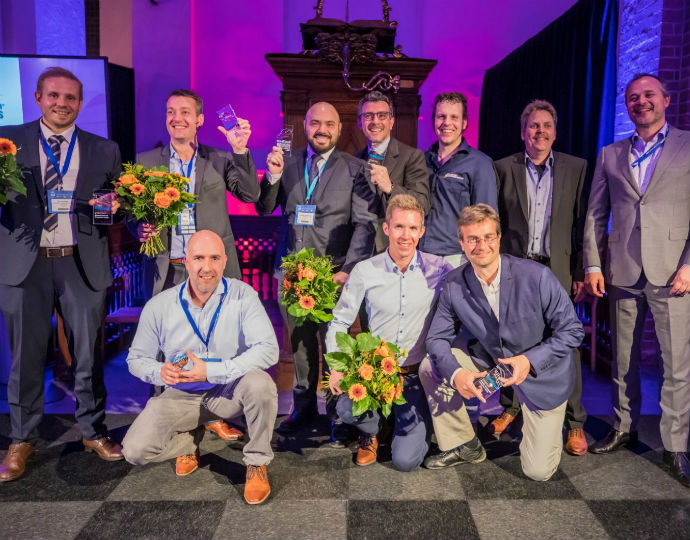With RailTech Europe 2021 less than a month away, the nominees for this year’s Innovation Awards are selected. In this article you can read about the nominated companies and how their innovation is relevant to the railway sector. Six Innovation Awards will be given out at the digital event RailTech Europe 2021.
“A central part of RailTech Europe are always the RailTech Innovation Awards”, says Kim de Vos, event manager. “This year as well, the awards will be part of the online edition and we are happy that so many companies sent in their interesting innovations. Innovations play an important role in the sector and we are happy to highlight them on RailTech Europe.”
Below you can find all the nominated companies with a short introduction about their innovation. Next to the six awards chosen by the jury, there is the additional Audience Choice Award, for which you can vote here.
The nominees for the Innovation Awards 2021 in each category are:
Infrastructure
- Network Rail Infrastructure, with Digitised Lineside Inspections (DLI) to manage vegetation on the railway through the use of remote sensing and machine learning.
- Infrabel, with a ready-to-use “Tetris rail network block” fitted with 2x 480 metres of track, ballast and 4 switches, which was placed on the line connecting Namur and Charleroi. The block allows traffic to resume faster, since it is prepared next to the tracks, which can remain in use during preparation.
- Triolight, with RailLight: a railway lighting product without light pollution with maximum safety, which is attached to the outside of the rails. The grazing light creates a shadow so that obstacles are clearly visible.
Rolling stock
- 3M Poland, with a project of improvement of safety at the rail-road crossings, supplying reflective, self adhesive films for PKP Cargo. With high angular retro-reflective films in reflective striping applied on cargo wagons, the night time visibility of moving rolling stock significantly improves
- AKKA Technologies, with FLEXMOVE: an electric rail-road autonomous vehicle that you can drive like a car on the road, and which drives itself on the rail tracks thanks to an autonomous driving system.
- 3M United Kingdom, by demonstrating how material choice can help reduce energy consumption and increase passenger comfort for Porterbrook Leasing. For example with 3M Envision Print Wrap Film with anti-graffiti overlaminate, the first non-PVC film developed for the rail market and produced with 60 percent less solvents than traditional PVC films.
Digitalisation
- GeoNext, with mobile laserscanning for the affordable acquisition of accurate (millimeter-level) and up-to-date 3D information. They have developed an approach for automatic information extraction from point clouds. Using machine learning, the point clouds are automatically classified and clustered, and then automatically a model is generated of all trackside objects, the track geometry, and the catenary system.
- Cognitive Pilot, with an autonomous driver assistance system for trains, designed to help drivers avoid errors that may lead to accidents, as well as improve fleet efficiency. It makes use of a camera, high-resolution radar, and AI, among other things.
- Network Rail, with the HMT1 WorkfloPlus, an innovative ‘Connected Worker’ solution with a hands-free voice-controlled user interface. It standardises and digitises existing renewals paper-based data collection and reporting activities. Integration with the ‘Track Locator’ app also means that the location of additional works or hazards can be accessed in real time.
Public Transport
- Molinari Rail, with a disinfection system for public transport, customisable for use in buses, rail vehicles or smaller aircraft types. It has a 4-pillar model combining ventilation, filtration and disinfection for the decontamination of interior air and surfaces in the room in one process.
- DB Vertrieb, with the Tickin app, which offers seamless changes between all means of transport. Reaching the destination, an algorithm analyses GPS locations and other smartphone sensor data to recognise the end of the trip, so no check0out is needed. Tickin was launched in June 2020 in the Rhein-Neckar region in Germany (VRN) with a population of almost 3 million residents.
- OXplus, which has designed and implemented the Capacity Planner for NS (Dutch Railways). NS faced a 30 percent increase in fleet size that had to be maintained with the same resources they already had. The Capacity Planner makes this possible, through smart algorithms, to make first time right capacity planning decisions based on AI and a self-learning system.
Start-up
- PANTOhealth, with a solution that detects defects in catenary (overhead lines) or pantograph before it results in a serious problem that prevents trains journey. It uses a combination of sensors, camera, and a processing board will be installed on the pantograph which will send the location of the train, acceleration signal, and geometry of the pantograph-catenary system to the server via a GSM module.
- Nevomo, with the Magrail system, a magnetic levitation hybrid solution allowing both magnetic vehicles and conventional trains to operate on the same lines – being first step towards gradual implementation of hyperloop. It will deliver ultra-high speeds (up to 550kph/342mph) within existing railway corridors.
- Civil Water Management Limited, with the TDS-400 drainage panels, made from recycled plastics that are destined for landfill or incineration in the UK, contributing to a circular economy. After many trials with Network Rail over numerous years, the product received a Certification of Network Product Acceptance.
Jury members
The jury for the awards consists of professionals as well as academics with expert knowledge of the railway sector. The jury has evaluated the entries and made the nominations, and will eventually choose the winner in each category. This years’ jury members are Matthias Landgraf, Senior Scientist at Graz University of Technology, Rob Goverde, Professor of Railway Traffic Management & Operations and Director of the Digital Rail Traffic Lab at Delft University of Technology, Erwin Abbink, Head of Innovation & Analytics at NS (Dutch Railways), Karel van Gils, Director Innovation & Technological Renewal at ProRail, Enno Wiebe, Technical Director at CER, and Claudia Falkinger, Innovation Strategist at Women in Mobility.


